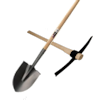Essential
Concepts
There are a few basic concepts that are absolutely essential for us to understand when we approach tool sharpening.
Without knowing these basics and applying them correctly we will never have sharp tools or enjoy using them.
Understand Cutting Edges
There are three different kinds of cutting edges that you will find on your garden tools. They are totally different structurally and operate in totally different ways. Pay close attention to each tool and observe the type of blade it uses or your sharpening could actually make it unusable.
1. Knife like blades such as that you find on an anvil pruner are angled and sharpened on both sides. With this type of blade it is important to keep both sides of the blade sharpened, essentially matching each other (usually with a rather sharp angle), to work well.
2. By-pass blades are completely flat on one side and are sharpened only on the opposing side. They cut by sliding very tightly against a second flat blade that is not sharpened at all but has a square edge on it. These blade setups are particularly sensitive to incorrect sharpening.
3. The third type of blade is similar to the by-pass blade but operates alone, basically allowing the surface of the ground or a root in the case of a shovel or hoe, or the surface of a branch in the case of a saw, to form the second side or flat side of a cutter.
The requirements for specific tools will be explained in the individual tool tutorials.
Know Which Side to Sharpen
So many hoes and shovels are sharpened on the wrong side you would think it didn’t really matter, but the truth is it matters a great deal. After reading this I think you will understand why.
Look at the image above. It represents a single blade sharpened first on one side and then the other. Study it carefully. It will make a dramatic impact on your thinking about the importance of sharpening the correct side of any given blade.
Sharpen Tools that Work Like Hoes
Think of it first as a the blade of a hoe. In this case you would be standing to the left side and hoeing into the ground. The correct way for the hoe to be sharpened is to sharpen the inside.
Many hoes when purchased have never been sharpened, it is up to you to sharpen them. If you look in the shopping centers you will also find that many come from the factory sharpened on the wrong side! Obviously many people have no experience using them.
But if you sharpen them on the outside (the top of the hoe when you stand the handle on the ground) you have a wider flat edge being forced into the ground than if it were left flat, not sharpened at all. Sharpened correctly they slice like a chisel.
Sharpen Tools that Work Like Shovels
Now think of a shovel. Picture yourself standing to the right.
In this case you should sharpen the shovel on the inside, or on the top side of the shovel as it enters the ground. Again, if you sharpen on the bottom side you actually leave a flat end hitting the ground, one that is larger than if it were not sharpened at all.
You may push it into the soil with your foot, but it is harder, and if you are trying to cut through a root it can make a real difference, tearing the roots rather than cutting.
Sharpen at the Right Angle
Our third consideration in this article has to do with the angle of the edge that needs to be put on your tools. Getting the right bevel on your blade is quite important but getting it right is not difficult, and though it is important there is lots of leeway.
Different tools require blades to be cut at different angles. We will not go into detail here but will raise the question with individual tools in the individual tool section.
The general principle is that the thinner the cutting blade, the smaller or flatter the angle. This means a saw or pruner will have a very sharp, thin angle and a shovel or hoe will have a bigger angle. Most tools fall into the 30-40 degree range.
Fortunately, most tools are pre-sharpened so you do not need to know precisely, just maintain it as it is. Also, be aware that there is a lot of subjective decision making as to the correct angle. Your judgment is as good as the next guy’s in all likelihood.
Conclusion: Remember These Concepts
As you learn to sharpen your tools, always keep these three ideas in mind: first determine the type of cutting edge in mind, be sure which side(s) of the blade to sharpen, and sharpen at the right angle.






